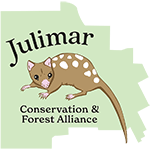Photo by S J Bennett. Creative commons license.
Written by Sharon Richards, President of the JCAFA
Original Article: May 2024 edition of the Toodyay Herald.
A SUCCESSFUL breeding program for the endangered Chuditch exists in the Julimar State Forest, from which there have been sufficient animals available to be used for relocation to other sites being rewilded around WA and South Australia.
Bear the above in mind as the Julimar Conservation and Forest Alliance was alerted last month that Chalice Mining had made an application to the Environmental Protection Agency to progress with the Gonneville mine
project.
The Chuditch roam within the proposed mine site area.
Any substantial project is required to be referred to the EPA which will then make a decision as to whether the project requires assessment.
Whilst the proposed mine site is not inside the Julimar Forest, the property abuts it and is less than 20 kilometres away from Toodyay.
The EPA put the proposal out for public comment on what level of environmental scrutiny should be given to the proposal. It can decide not to assess the project, an unlikely outcome given the size and location
of the proposed mine.
Otherwise, the assessment can be done at five different levels. The lowest level of assessment, Referral Information, means the EPA assesses and makes a decision about whether the proposal may proceed – on the documents received from Chalice.
The highest assessment level, called Public Environmental Review, requires a full environmental review and if this level is chosen the public can make submissions. Once this report and recommendation has gone to the Minister there is a further 14 days for public comment and appeal.
In response to the Chalice application, over 740 submissions were made by the general public, with over 710 of those asking the EPA to undertake the highest level of scrutiny possible for the Gonneville project proposal, a Public Environmental Review.
Within the Chalice proposal an area for particular concern was the proposed clearing of 940 hectares of remnant vegetation.
The term wildlife/green corridor is one used to describe the linking of habitat areas which enable wildlife populations to move around more easily to forage for food and find suitable breeding partners and habitat.
The larger the area, the greater the chance that wildlife will thrive and aid the recovery of populations which may have been impacted by such things as fire or human intervention.
To the north, Julimar Forest abuts the Bindoon Training Area, an area of 20,200 hectares. To the south and south west of Julimar is the proposed mine site which then links with the Moondyne Nature Reserve, through to the Avon Valley National Park and further west, Paruna and Walyunga National Park, a combined area of 19,500 hectares.
These areas combined provide an area of 68,300 hectares within which wildlife currently roams relatively unhindered.
If the area of 940 hectares is cleared as proposed it will impact this green corridor and effect the ability of fauna to travel south. Our native fauna does not understand boundaries so is quite likely to be impacted by this proposal.
If you would like to know more about the Environmental Protection Authority process and how you can have your say, the website is www.epa.wa.gov.au.

